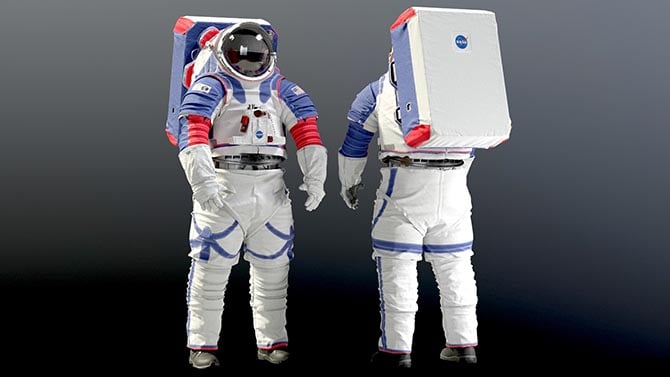In an announcement released on Wednesday, June 26, NASA stated that it has abandoned its plans to develop next-generation space suits. This decision ends the agreement with Collins Aerospace, which aimed to deliver the new suits by 2026.
The contracts involved, which have now been terminated, were valued at over $100 million. NASA justified its decision by stating that Collins Aerospace could not meet the necessary development timeline to support the objectives of the space station and the agency’s missions.
NASA expressed its disappointment over the end of the contract and indicated that it is seeking alternatives to continue advancing its goals in space exploration. Collins Aerospace has not yet issued an official statement regarding the decision.
This course change poses a significant challenge for the space agency, which must now rethink its strategies for the future of spacewalks and potential innovations in suit design.

NASA astronauts currently use space suits known as Extravehicular Activity (EVA) suits. These suits were developed over 40 years ago to enable astronauts to conduct spacewalks and other activities outside spacecraft and space stations. The EVA suits are crucial for protecting astronauts from the extreme conditions of space, providing life support, temperature control, and shielding against radiation and micrometeoroids.
Recently, NASA faced a significant issue with the EVA suits when a mission was interrupted due to a leak in a suit worn by astronaut Tracy Dyson. The leak affected the suit’s cooling system, which is essential for maintaining a comfortable internal temperature while working in space. This incident forced NASA to delay plans to remove a malfunctioning electronics box from the exterior of the space station, a critical maintenance operation for the station.
With NASA’s recent decision to cancel the plans for developing new EVA suits, questions arise about how the space agency intends to address the modernization or replacement of these suits. Although the current suits were designed several decades ago, updating or replacing them is vital to ensure the safety and effectiveness of future space missions.
As NASA grapples with these challenges, other companies are also developing new space suits. Axiom Space, based in Houston, has a contract with NASA worth nearly $230 million to develop new suits. However, Axiom’s suits are being designed with a focus on lunar exploration and are not specifically intended for the International Space Station (ISS).
Axiom Space’s project represents a parallel approach to the development of EVA suits and reflects the growing interest and investment in space technologies that meet various needs and exploratory goals. Collaboration and innovation in the space sector continue to evolve, indicating a promising future for space exploration and activities.
Additionally, SpaceX, known for its crucial role in transporting astronauts to the ISS, is also developing its own EVA suit. In May of this year, the company revealed the design of its new suit, which is part of a broader initiative related to the Polaris Dawn mission. Polaris Dawn is a private project funded by billionaire Jared Isaacman and may mark the first spacewalk by a private company and a civilian astronaut. This mission is scheduled for this summer and represents a significant advancement in private spaceflight.
The development of space suits by various companies reflects the increasing collaboration and innovation within the space sector, with different approaches and technologies tailored to the diverse needs of future missions. The ongoing evolution of these suits and the integration of new technological solutions will be crucial for the success of upcoming phases of space exploration.
NASA’s decision to cancel plans for developing new EVA suits in partnership with Collins Aerospace has raised questions about the agency’s next steps. NASA has yet to address whether the suits developed by Axiom Space, which has a nearly $230 million contract with NASA for lunar missions, could be adapted for the ISS. Similarly, SpaceX, which recently unveiled its own EVA suit design, has not provided information on whether NASA has reviewed or considered these designs for the ISS. SpaceX, under the leadership of Elon Musk, is known for often not answering questions from news organizations.
In addition to these challenges, NASA is also facing uncertainty regarding the future of the ISS. The U.S. space agency plans to decommission the space station within the next few years and has detailed its plans for dismantling the ISS after its retirement in a recent press release. NASA is committed to continuing the station’s operation until 2030, but participation from Roscosmos, the Russian space agency, is secured only until “at least 2028.”
This scenario underscores the need for swift and effective solutions to ensure the continuity of operations and the safety of future space missions. Collaboration between various agencies and companies will be crucial in addressing these challenges and paving the way for the next phase of space endeavors.
Extravehicular Activity (EVA) suits play a critical role in space exploration and are essential for the safety and functionality of astronauts during activities outside spacecraft or space stations. Designed to withstand extreme conditions in space, these suits provide protection against cosmic and solar radiation, extreme temperatures, and micrometeoroids. They maintain the necessary internal pressure for survival, supply breathable oxygen, remove carbon dioxide, and enable communication with mission control while supporting the operation of equipment.
Moreover, EVA suits are designed to facilitate mobility and handling of tools in microgravity, making complex tasks easier. Safety in emergencies and contributions to future lunar and Mars missions are also crucial. The continuous development and maintenance of these suits are vital for the safety of astronauts and the success of space missions.

